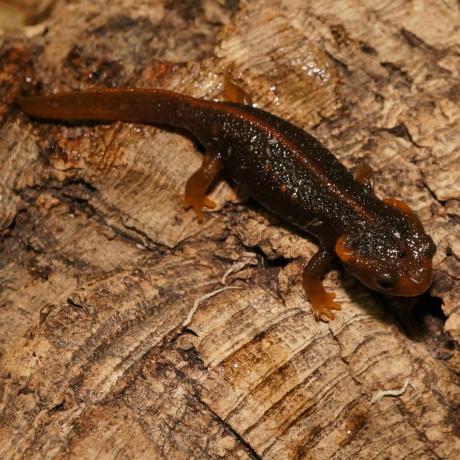

An attractive large and robust species also known as Himalayan Nobby Newt.
| Origin | China, India, Myanmar, Nepal, Thailand and Vietnam |
|---|---|
| Environment | Semi-aquatic |
| Adult Size | 16-20cm |
| Suitability | Intermediate |
| Lifespan | 10 years+ |
An attractive large and robust newt that has a chocolate brown-to-black base colouration. They have a broad and flattened looking appearance with areas of orange or orange-brown on the tail, head, limbs and tubercles of the rib peaks and along the vertebral ridge.
Adult females are considerably larger, often by 2-4cm.
These newts reach lengths between 16-20cm.
In the wild Crocodile Newts can be found in Yunnan province of sourthwestern China, northern Burma, Northern Thailand, Vietnam, India and eastern Nepal.
These newts seem to favour areas of high elevation and can be found around mountain forests near pools, streams or lakes.
Crocodile Newts should be kept semi-aquatic as a rule, although individual’s may favour a terrestrial (on land) or aquatic state at varying times throughout the year, we believe it’s best to give them the choice.
In captivity, these newts can be easily kept in a simple glass terrarium of around 60cm in length. Expensive heating or lighting equipment is not necessary but we would still advise providing a low percentage UVB light via an overhead canopy.
Temperatures should not exceed 22C during the summer, and over the winter they can be hibernated as they will tolerate low temperatures. This is advisable if you wish to breed your newts in the spring.
Remember all water needs to be treated with a good quality dechlorinator to remove harmful chemicals from the water before use, and it's advisable to have a low powered filter in the tank to keep the water quality at it's best.
Provide a minimum substrate layer of 7-10cm. This must be soil based and kept damp but not waterlogged. Add sphagnum moss along with rocks, bark and logs.
Alternatively, you could create a bio-active setup by adding live plants and creating further interest in the terrarium. When doing this, you must remember that you will need to provide additional lighting to the terrarium to aid with plant growth.
Live food should be offered in the form of Bloodworm, Crickets, Curly-wing flies, Earthworms and Locusts. Choosing the correct size insect is important, if they are too large they will be ignored. Remember that you must ensure all your insects are well gut loaded before feeding them to your animals.
Offer live food to your newts every other day and ideally remove any uneaten live food by the next morning. However, we’d advise using personal judgement here as it pays not to constantly disturb their habitat as this will inevitably cause unnecessary stress. You can adjust levels of feeding depending on how much is being consumed, once they are established.
Lastly and most importantly you must use a good quality dusting powder to provide essential calcium and vitamins to your newts. The traditional method of application is to use a spare live food tub or empty cereal container to coat the insects lightly in whichever dusting powder you are providing. We’d advise dusting your insects on every feed but to alternate between calcium and vitamin powders with the ratio of (2.1).